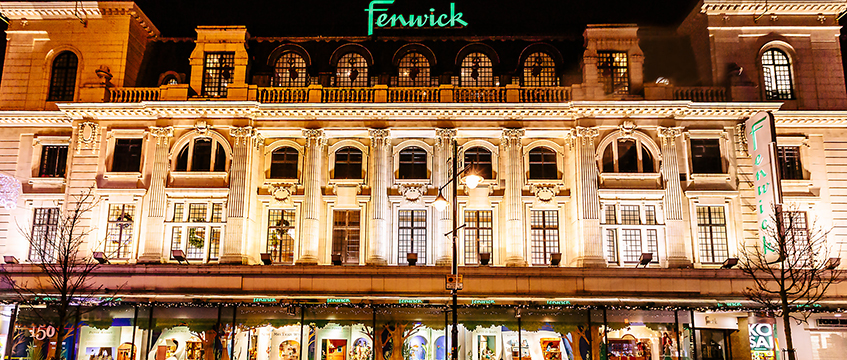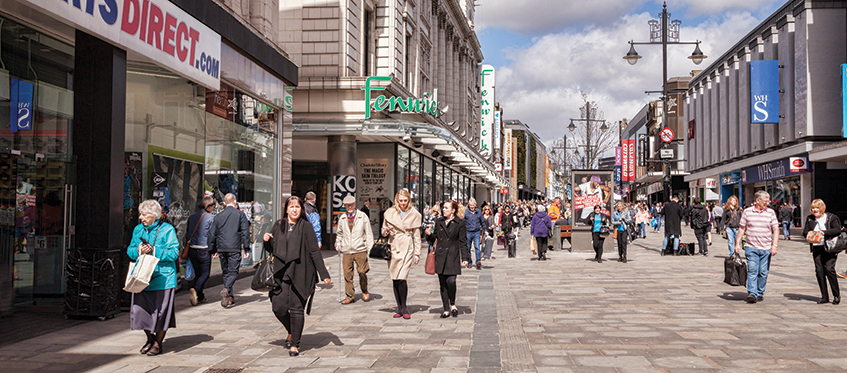Newcastle’s Northumberland Street may be the most credible of the half dozen contenders for the title “Oxford Street of the North,” writes David Thame.
It is an essential part of the city’s self-definition and a busier half-mile of pedestrianisation is hard to find – footfall is estimated to be around 24m a year.
Yet for all its psychological and historical significance, the street is widely believed to be suffering. High fashion has gone, fast food has arrived, and while plenty of people walk down Northumberland Street the consensus is that most of them are on the way to somewhere else.
Later this autumn yet another report into the future of the street is due to be published. This time, could it make a difference? What lessons can other dominant regional shopping pitches draw from Northumberland Street’s journey?
The report – being prepared by Cushman & Wakefield and architects FaulknerBrown at the invitation of NE1 and the city council – is by no means the first. A Donaldsons analysis dated 2007 noted that the east of the street “is now looking tired and/or underused” but rated the chances of redevelopment “not viable.”
In 2012 a public realm study by urban design and landscaping consultancy J & L Gibbons reported a long list of groans including lack of trees, street clutter, a mess of cycling and vehicle access, poorly managed market stalls and pavement cafés and performance space, pedestrian congestion and bad street furniture. The lack of a “cultural strategy” was also noted, and its reputation as the Oxford Street of the North assigned to nostalgia, not quality of visitor experience.
It concluded: “The overwhelming general consensus is that urgent intervention is necessary.”
Speaking at a city council presentation late last year, chief executive Pat Ritchie promised a “transformational vision” led by an independent working group under the chairmanship of Mark Williams, former chairman of the government’s retail property taskforce, and director of the Hark Group.
Ged Bell, cabinet member for investment and development at Newcastle City Council, said at the launch of the latest study: “This is an essential piece in the jigsaw that will help inform and shape our ambition to transform Northumberland Street into a world-class shopping and leisure destination.
 John Percy, partner and head of Cushman & Wakefield’s retail development team, is the man in charge of the rethink. His team has been tasked with devising a number of interventions to boost footfall to the area, which is home to iconic department store Fenwick, including enhancements to the existing public realm as well as other opportunities to transform its role as a key driver of the wider city. With easy wins like pedestrianisation and some smarter street furniture having already been tried – and failed – it will not be an easy job.
John Percy, partner and head of Cushman & Wakefield’s retail development team, is the man in charge of the rethink. His team has been tasked with devising a number of interventions to boost footfall to the area, which is home to iconic department store Fenwick, including enhancements to the existing public realm as well as other opportunities to transform its role as a key driver of the wider city. With easy wins like pedestrianisation and some smarter street furniture having already been tried – and failed – it will not be an easy job.
“The idea that Northumberland Street isn’t trading to its maximum potential has been a nagging theme, but the street has enormous potential,” he says. Forget Oxford Street, think Regent Street of the North, Percy hints.
“Actually, it does perform well, there are no huge vacancies, it is not a failed place. The question is how to make the best use of that footfall?”
The answer is beginning to emerge from comparisons with the major thoroughfares of Glasgow, Hamburg and Lisbon, port towns with some cultural similarities.
Percy’s conclusion so far is that the old solutions won’t work because a one-off revamp has only short-term effects. “You could plan to spend millions on the public realm, and achieve nothing if there is no thinking about the long-term, and no legacy organisation to look after it,” he says. “The big discussion will be how that structure might work, but you need a structure with teeth. You need a mechanism for doing things.”
Talk to others in Newcastle and you quickly discover the sense of frustration to which Percy is responding.
Bill Lynn, director at Lambert Smith Hampton, says the latest effort is “fine” and points out that the street trades well, with few vacancies at a rent recovering well from a recessionary low of £250 per sq ft zone A to just north of £300.
However, he adds: “Reports won’t attack the underlying issues. The solutions on offer are superficial because they won’t fundamentally change the street, which has come down a notch or two in the quality of retailers. New street furniture isn’t going to change that. And yes, tidy the street up, but there’s more to the problem than that.”
Lynn says the real issue is changing the retail mix. “Getting the key occupiers back is what matters – but Next won’t come back, Hollister won’t come back,” he says, and points to the retail pulling power of intu’s Eldon Square, and Standard Life’s high-fashion Monument Mall.
“It would be good to see Hugo Boss in Northumberland Street, but they wouldn’t come out of Monument Mall, which is a shame because the key is getting the fashion back. Frankly, today, nobody is going to come to Northumberland Street for the sake of a branch of Costa Coffee,” he says.
John Percy understands perfectly. “We’ve got to make Northumberland Street more of an experience because today it’s just lost in a sea of retail and I don’t think many would necessarily think explicitly ‘I want to go to Northumberland Street’,” he says.
Coherent street management and the kind of events programme that has helped Regent Street and Grosvenor’s Liverpool One, could be part of the answer, he says. “Maybe a performance space, maybe complimentary events,” he says but adds: “This exercise needs buy-in from all stakeholders in the street.”
Buy-in could be literal – actual money changing hands – and that is where refashioning Northumberland Street gets complicated because unlike Regents Street or Liverpool One, Northumberland Street is not in a single ownership.
Buy-in from Intu and Fenwick would be essential but it’s not clear to what extent it would be forthcoming: intu declined EG’s invitation to talk about their aspirations for the street and Fenwick did not respond. The city council say that as yet they are “not in a position to talk through the delivery mechanism … we’re not that far in the process of feasibility.”
Some cynics suggest that until Northumberland Street’s performance gets too bad to ignore, buy-in will not be forthcoming. Today’s so-so performance is – they hint – an obstacle to long-term change.
The Cushwake/FaulknerBrown report is expected to reach the city council by the end of the year. It is understood there is no formal timetable for what happens next, but whatever comes it will depend on landlords as much as the city council.
Pilgrim’s progress….
The 41-acre East Pilgrim Street area of central Newcastle is expected to see more than 500,000 sq ft of new comparison retail and is regarded as the natural extension of Newcastle’s retail core. With the Laing Art Gallery at its heart, and plenty of listed buildings, it could provide the kind of funky metropolitan space shoppers love to visit. A development strategy was approved by the city council late last year.
East Pilgrim Street is officially an “accelerated development zone” although some think acceleration isn’t much in evidence. Even so there is plenty of hope, buoyed by early signs of activity on some sites, necessary highway changes and the diversion of bus routes to produce more organised pedestrian-friendly space. But there is also some scepticism.
A city council spokeswoman said: “This has been quite challenging given the Reuben Brothers own much of the real estate in that area. We have been working hard over the past couple of years since we saw Simon Reuben in person, and Motcomb Estates now manages the property portfolio on their behalf, so we’ve taken an active role in trying to encourage investment.”
Motcomb are now working on schemes for the southern block (the old Bank of England site), they are working on the fire station and police station.
John Percy, partner at Cushman & Wakefield, says: “This has to complement Northumberland Street, and the physical linkages have to be right. It’s vital it doesn’t block access, or pre-empt changes at Northumberland Street, or simply doesn’t fit with Northumberland Street.”











